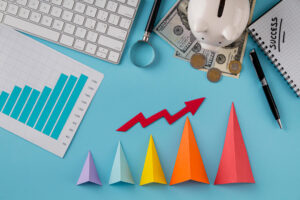In the wide world of auditory art, music production stands as a fascinating intersection between creativity and technology. It’s a process that transforms a simple melody or a beat into a full-fledged musical track that can captivate listeners, evoke emotions, and sometimes, even define generations. Whether you are an aspiring musician, a curious listener, or an avid music enthusiast, understanding how music is produced can deepen your appreciation for the final masterpiece that flows through your speakers.

Image from Pixabay
Table of Contents
The Composition – Where It All Begins
Every piece of music starts with an idea. It could be a tune that strikes a composer at dawn or a powerful lyric that speaks volumes by itself. Songwriters and composers sketch these musical ideas through notes and lyrics, crafting the primary blueprint for what will become a fully fleshed-out track.
“The Composition – Where It All Begins” reflects on the birthplace of every musical piece: the initial concept. Like the first rays of sunlight inspiring the day, melodies or provocative words often ignite the creative spark in a composer’s mind. These fragments of inspiration are as diverse as the songwriters themselves, each carrying the potential to resonate deeply with human emotions.
Conceiving a composition, much like erecting a building, starts with drafting a blueprint. Composers and songwriters act as architects of sound, using notes and words as their building blocks. They begin by etching these foundational elements onto staff paper or a digital workspace. This skeletal framework, although simple in form, contains the DNA of the future masterpiece.
The early drafts represent a raw, unpolished version of the final work. They often undergo numerous revisions, with the composer molding the contours of melody, harmony, and rhythm, much like a sculptor shapes clay. These sketches are crucial—they’re the seed from which the song’s full expression will eventually bloom. Through layers of instrumentation, arrangement, and production, what begins as a solitary idea gradually transforms into a rich, complex creation that can stir the soul, inciting a multitude of feelings and responses in its audience.
In essence, composition is the genesis of a musical journey, with each piece tethered to its initial, sometimes fleeting moment of inception. This magical starting point is where composers connect with the intangible and bring it into the world through their unique artistic vision.
Laying Down the Foundation – Demos and Arrangements
Once the core idea is in place, a demo is often recorded. This rough version helps to experiment with different elements like melodies, harmonies, and rhythms. Arrangement is the next vital step, where decisions about the structure of the song are made, including intros, verses, choruses, bridges, and outros.
Creating a song typically begins with a core idea that often emerges from a melody, a lyric, or a chord progression. Once this seed of inspiration is, the next phase of the process involves laying down the foundation through the creation of demos and arrangements.
Demos: A demo is a preliminary recording of a song, meant to capture the basic essence and potential of the musical idea. It’s not about achieving perfect sound quality or final vocal takes; it’s about getting the idea down in an audible form that can be shared and developed. During the demo stage, artists and producers start to experiment with the song’s components, such as tweaking the melodies to catchier tunes, adjusting the harmonies to enrich the sound, and playing with different rhythms to find the right groove. This is a creative, sometimes messy, phase, where the goal is to explore the possibilities of the song.
Arrangements: After the demo version crystallizes the idea further, the focus shifts to arrangement, which is the process of determining the structure and the overall sonic palette of the track. Here, decisions are made about the order and length of different sections of the song: where it will start (intro), where the story or main message will be told (verses), the emotional or lyrical climax (choruses), any contrasting sections (bridges), and finally how it will end (outros). Additionally, arrangement includes choosing the instruments and sounds that will be used, how these elements will interact throughout the piece, and the dynamics of the song—where it will be loud, soft, or build in intensity.
Demos and arrangements are about crafting the song’s identity, taking the core inspiration and shaping it into a form that resonates with listeners, often requiring several iterations before the song feels ready for the next stage, which is typically the production and recording of the final version.
The Recording Session – Capturing the Sound
With a structure in hand, the actual recording starts. Musicians and vocalists enter the studio to lay down their tracks. This is where the technical magic starts with the use of microphones, audio interfaces, and digital audio workstations (DAWs). Each instrument is usually recorded separately, allowing for greater control over the final sound.
Once pre-production stages like demoing and arranging are complete, attention shifts to the recording studio for the main event: capturing the song’s sound with precision and clarity.
Musicians and Vocalists: The recording session often begins with rhythm section instruments like drums and bass, which provide a song’s foundational groove. Other instrumentalists—guitarists, keyboard players, etc.—follow, laying down their parts while listening to the already recorded tracks through headphones to maintain timing and cohesion.
Technology’s Role: A modern recording studio is an intersection of art and technology. High-quality microphones carefully capture the nuances of each performance, feeding the sound into audio interfaces that convert analog soundwaves into digital signals. These signals are then processed within Digital Audio Workstations (DAWs), like Pro Tools, Logic Pro, or Ableton Live, providing engineers and producers a powerful platform for recording, editing, and mixing.
Multitrack Recording: In contemporary music production, multitrack recording is standard. It allows individual recording of each instrument and vocal on its own separate track. This method offers unparalleled flexibility during the editing and mixing phases, letting engineers adjust levels, apply effects, and correct timing and pitch issues on a granular level.
Layering and Overdubs: During the session, artists often record multiple takes of each part, providing a variety of performances to choose from. Additional layers—harmonies, auxiliary percussion, or extra guitar riffs—can be added through overdubbing, where new recordings are layered on top of existing ones without disturbing the original tracks.
Capturing Emotion and Energy: Technological precision aside, the essence of a recording session is to capture the emotion and energy of the performances. The ambiance of the recording space and the vibe from the musicians play an integral role in imbuing the song with a living, breathing quality that resonates with listeners.
The culmination of these recording sessions is a set of raw tracks, each holding a piece of the musical puzzle, ready to be polished and woven together in the mixing stage.
Editing – Polishing the Pieces
After the recording, the editing process begins. This step involves comping (selecting the best parts of multiple takes), timing corrections, and pitch adjustments. It’s a meticulous process that ensures each note and beat sits perfectly in place.
Editing in music production is a critical post-recording phase, where raw tracks are refined into a polished final piece.
Comping:
When artists record, they often perform several takes of the same part. Comping is like assembling a puzzle; the engineer listens to multiple performances and selects the best portions—maybe a verse from take three, a chorus from take one. This crafted track should sound seamless, as if the artist delivered a perfect performance in one go.
Timing Corrections: Music relies on precise timing for coherence and impact. During editing, subtle discrepancies—that human touch—can be smoothed out. Engineers use digital tools to nudge notes, aligning them with the intended rhythm. It’s a balancing act; too much correction risks a robotic feel, too little leaves the music feeling sloppy.
Pitch Adjustments: No performance is pitch-perfect. Modern software can fine-tune off-key notes, preserving the natural tone of the instrument or voice while ensuring harmony is maintained. This is done note by note, with a careful ear to avoid the artificial sound over-processing can bring.
Each step requires a detailed ear and a vision of the final product to ensure the authenticity of the music isn’t lost in its technical perfection.
Mixing – Blending Artfully
Mixing is an art form all its own. It’s about balance and blending the individual tracks to create a cohesive whole. Mix engineers adjust levels, pan audio, apply equalization, compression, and add effects like reverb and delay. Their goal is to ensure that all elements are heard clearly, work well together, and contribute to the song’s overall mood.
Mixing in music is akin to painting on a sonic canvas, a stage where the raw recordings are transformed into a captivating auditory experience.
Balance and Blend:
Imagine each track as an individual color; mixing is the art of blending these colors to create a harmonious painting. Engineers must adjust the volume levels, ensuring no instrument overshadows another unless intentionally designed for effect. Each sound should be distinct yet contribute to the ensemble.
Equalization (EQ): Equalization is a process akin to sculpting; it shapes the tonal quality of each track. By boosting or cutting frequencies, engineers can make each instrument shine on its own and fit perfectly with others. EQ helps in clearing muddiness and avoiding frequency clashes, which can mask sounds in the same range.
Compression: This tool is like a subtle guide to dynamics, ensuring that every quiet nuance is heard and that loud peaks do not overpower the mix. Compression controls and evens out the dynamic range of a performance, allowing for a more consistent listening level.
Effects: Reverb and delay are the finishing touches, the equivalent of adding texture and depth. Reverb can make a sound appear to be in a large hall or a small room, while delay can create echoes or a sense of rhythmic complexity. Applied artfully, effects contribute to the emotional impact and atmosphere of the track.
The mix engineer’s goal is to craft a mix where clarity, dynamic interest, and tonality work together, offering a compelling rendition that captures the listener’s imagination and conveys the song’s intended emotion.
Mastering – The Final Sheen
Mastering is the final stage of the production process. It involves fine-tuning the mixed track to optimize the sound for various playback systems. The mastering engineer works on enhancing the sonic qualities, ensuring consistent sound across the album, and preparing the track for distribution.
Mastering—often regarded as a mysterious and delicate art—is where a song receives its final polish and sheen before being released into the world. It’s the last opportunity to refine and perfect the recording.
Optimization for Playback: The mastering engineer’s task begins with scrutinizing the mix for its ability to translate well across a wide array of playback systems, from high-end stereo systems to smartphone speakers. This optimization ensures the track sounds its best, whether it’s played in a car, on earbuds, or over club speakers.
Sonic Enhancement: Mastering involves subtle sonic enhancements. This could mean using equalization to gently shape the overall tone, increasing clarity or warmth where needed, or applying compression to unify the dynamic range and add punch, making the track more robust and powerful.
Volume Maximization: Another key component is achieving competitive loudness while preserving dynamic integrity. The mastering engineer delicately balances loudness to make the track stand up alongside others in the market without sacrificing its dynamic feel or causing distortion—a process sometimes known as ‘loudness normalization.’
Consistency Across the Album: In the context of an album, EP, or multi-track release, mastering ensures there is consistency from track to track. This involves matching levels and tonal quality, so the listening experience is seamless. The flow of an album is crucial, and it’s the mastering engineer’s job to maintain a coherent sound narrative throughout.
Track Sequencing and Spacing: The engineer also sequences the tracks in the correct order, paying attention to the gaps of silence between tracks—another subtle but essential element of the listener’s experience.
Preparation for Distribution: The final step includes preparing the master in the required format for distribution—whether that be vinyl, CD, streaming, or download. Each medium has its own technical requirements, and part of the mastering process is to ensure compatibility and the best sound quality for each format.
Metadata Embedding: Mastering also involves embedding ISRC (International Standard Recording Codes) and metadata into the tracks, which allows for tracking and royalty attribution across digital platforms.
The art of mastering is about making final adjustments that might be almost imperceptible individually, but collectively they have a profound impact on the listening experience. The end goal for the mastering engineer is to deliver a master that is both timelessly musical and technically impeccable.
Distribution – Music Meets the World
With production complete, the track is ready to meet its audience. In the digital age, this often means distribution through online platforms like Spotify, Apple Music, and Bandcamp. Physical media like vinyl or CDs go through a manufacturing process before hitting the shelves.
Distribution is the bridge between the creation of a music track and its listeners. In today’s digital-dominated music industry, when a piece is finalized, the primary method of sharing it with the world is through digital streaming services. Platforms such as Spotify, Apple Music, and Bandcamp are popular choices among artists and record labels for their wide reach and user-friendly interfaces.
Artists or their representatives usually upload their tracks to these online platforms, which then make the music available to millions of subscribers worldwide. The convenience of these services has revolutionized music consumption, allowing instant access to songs with just a click.
For those who favor a tangible music experience, physical copies are made available as well. Despite the rise of digital media, there is still a significant market for vinyl records and CDs. These formats undergo a manufacturing process where the music is transferred onto the physical medium, encased in branding and protective packaging, and then shipped to retailers to be sold in stores.
Thus, “Music Meets the World” through this melding of digital convenience and physical artistry, ensuring that the track reaches a diverse and globally spread audience, catering to various listening preferences.
The journey of a song, from an initial idea to a track on your playlist, is a remarkable testament to human artistry and technological progress. Behind every beat you dance to, every riff you hum, and every lyric that resonates with you, there is a story of production, underscored by the creativity and diligence of countless individuals.
Understanding the many-layered process of music production enhances our appreciation for the final product and highlights an often unsung narrative of creative collaboration. In the digital age, these processes are more accessible than ever, inviting anyone with a passion for music to venture into the captivating world of music production.
FAQ: The Magical Symphony of Music Production: Understanding the Art and Science
Music production is the process of creating, recording, refining, and finalizing a piece of music. It involves a combination of art, for the creative aspects, and science, for the technical implementation, resulting in a complete and polished track.
Not necessarily. While high-quality equipment can enhance the production process, many professional-sounding tracks are produced using affordable gear and software. Creativity and skill in using the tools you have are often more important than the cost of your setup.
Mixing is the process of combining multiple audio tracks and adjusting levels, panning, and effects to achieve a balanced and dynamic sound. Mastering is the final step, where the mixed track is fine-tuned to ensure it sounds its best across various playback systems and is properly prepared for distribution.
Independent distribution is very much possible with various online platforms available for artists to release their music directly to the audience. However, partnering with a label can provide additional resources, expertise, and promotion that might be challenging to manage independently.
A good music producer possesses a blend of musical talent, technical knowledge, and the ability to understand and realize the artist’s vision. Good communication, patience, and a keen ear for detail are also crucial qualities.
Mastering is vital as it provides the final polish to the track, ensuring consistency across the album and compatibility with different sound systems. It can significantly affect the perceived quality and impact of your music.
Yes, many music producers are self-taught, learning through online tutorials, experimentation, and practice. While formal education can be beneficial, the vast array of resources available online makes it possible to develop the necessary skills independently.
A Digital Audio Workstation (DAW) is a software platform used for recording, editing, mixing, and producing audio files. Popular DAWs include Ableton Live, FL Studio, Logic Pro, and Pro Tools.
The time it takes to produce a song can vary greatly, typically ranging from several days to months, depending on the complexity of the project, the level of perfection sought by the artists, and practical aspects such as availability of the team involved.
Sound engineers play a crucial role in music production, handling the technical aspects of recording, editing, and mixing audio to achieve the desired sound quality and clarity, ensuring the artist’s vision is captured and conveyed effectively.





























